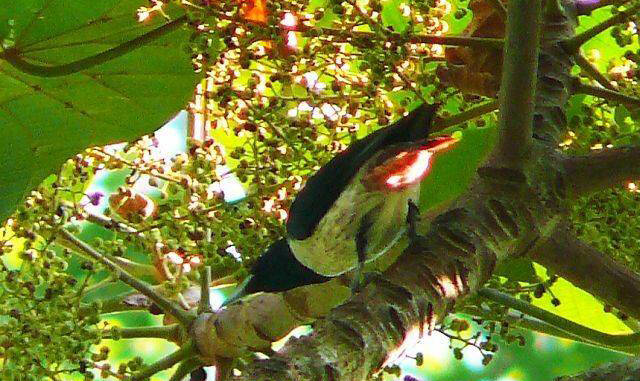Oriolus mellianus
IUCN
LCBasic Information
Scientific classification
- name:Oriolus mellianus
- Scientific Name:Oriolus mellianus,Silver Oriole,Magpie oriole, magpie-colored oriole, magpie-colored oriole
- Outline:Songbird
- Family:Passeriformes Songbirds Orioleidae G.Oriole
Vital signs
- length:23-26cm
- Weight:75-82g
- lifetime:8-10years
Feature
The head is brilliant black; the back feathers are silvery white. It can change its tone and imitate the calls of other birds.
Distribution and Habitat
Distributed in Cambodia, China and Thailand.
In China, it is distributed in Longtou Mountain in northern Guangdong, Yaoshan in Guangxi, Leibo and Mabian in Sichuan.
It lives in mountain forests below 2,000 meters, especially in secondary broad-leaved forests and sparse forests.
Appearance
Male adult Magpie Oriole: head is shiny black; back feathers are silvery white, with large triangular purple-red spots in the middle of each feather, which are exposed between the white feathers to varying degrees, forming scattered feather spots; shoulder feathers are the same color as back feathers; wing coverts and flight feathers are shiny black; tail feathers are light purple or reddish brown, with the outer vane edges of each feather dyed silver-gray, and the feather shaft is white except for the tip and the feather blade; the lower body below the chest is the same color as the back feathers; the undertail coverts are the same color as the tail feathers, with a wide silver-white edge on the feather edge; the thigh feathers are black-brown.
Female adult: head is shiny black-brown; back feathers are gray-brown, with dark brown feather shafts of each feather, and the whole has vertical stripes; shoulder feathers are the same color as back feathers; wing coverts and flight feather
Details
Silver Oriole, a medium-sized songbird, is a single species with no subspecies differentiation. It was once a subspecies of the red oriole.

Silver Oriole is a summer migratory bird. Arboreal, often moving alone or in pairs, sometimes seen in loose groups of 3-5. Mainly active in the canopy of tall trees, rarely coming down to the ground. During the breeding period, it likes to hide in the branches and leaves of the canopy and sing. The song is crisp and melodious, rich in elasticity, and can change the tone and imitate the songs of other birds. It sings most frequently in the early morning, sometimes singing while flying, and the flight is in a wave-like manner. It flies between branches to feed on insects, berries, etc. It migrates to the breeding area in April every year. Most of the male birds appear first and mate soon. The song is loud and varied. The main food is insects, such as adults and larvae of Coleoptera, Hemiptera, Lepidoptera, and mantises. It also eats plant fruits and seeds. The flying posture is in a straight line.
Magpie oriole migrates in April and leaves the breeding ground in August-September. The male bird sings crisp and pleasant during the breeding season. The bird builds a hanging nest at the base of the horizontal branches of a tall tree. The male and female use bark, hemp fiber, grass stems, etc. to weave a hanging basket-shaped nest between the horizontal branches. Each nest lays 4-5 eggs, and the egg shells are shiny. The female bird incubates the eggs, and the incubation period of the eggs is 13-15 days; the two sexes are responsible for raising the chicks, and the chicks stay in the nest for 14-15 days; the chicks still need to be cared for by their parents for about 15 days after leaving the nest.
The distribution range of the Magpie Oriole is narrow and limited, and it is believed that there is a trend of moderate population decline. The decline is due to habitat loss, reduced precipitation, tourism impact, and road development, which have caused changes in the living environment. It has been listed as an endangered species.
Listed in the IUCN Red List of Threatened Species in 2016 ver 3.1 - Endangered (EN).
Listed in China's National List of Key Protected Wildlife (February 5, 2021) Level 2.
Protect wildlife and eliminate game.
Maintaining ecological balance is everyone's responsibility!








